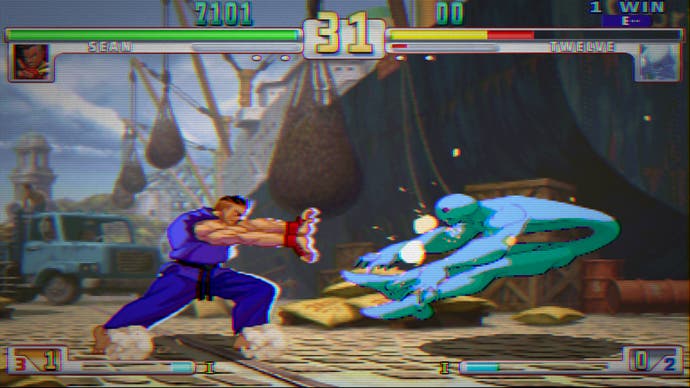Street Fighter III: Third Strike
Knock you out.
It's all a matter of timing. When Capcom pushed Third Strike into arcades in 1999, every member of its development team believed that this was the final, flawless evolution of Street Fighter.
It was, as the name suggests, the third iteration of Street Fighter III. Many disgruntled consumers consider Capcom's tradition of releasing three revisions to each of its prizefighters little more than a money-grabbing exercise. Perhaps, for the shareholders, this is true. But for the design team on the frontline it's a stepladder towards perfection, each iteration amplifying the successes of the preceding game and diminishing its shortfalls. And they know that three strikes and you're out. Better make sure the final swing counts.
It's all a matter of timing. While Third Strike was a game that refined all that had gone before, thanks to the state of the 2D fighting genre at the turn of the millennium, few were really paying attention. The previous decade had seen Capcom flood the market with Street Fighter-themed product in attempt after attempt to, at best, recapture Street Fighter II's heyday, or at worst, work the series' icons like wizened salesmen. By 1999 ennui had set in, not only amongst the general gaming public, but also within the core fighting fan base. Indeed, following Third Strike's release, it would be nearly a decade before we saw another mainline entry to the series.
So while Third Strike's development team believed they had perfected the 2D fighter with this game, what should have landed as a sucker-punch provided just a glancing blow. Critics awarded the game lacklustre praise. Sales of the subsequent Dreamcast release were modest.
Nevertheless, it was a blow with repercussions. Each year more and more players registered their interest to compete at Third Strike at fighting game tournaments around the globe. There was something at the heart of this game that was building a community and then sustaining it. While the game looked like orthodox Street Fighter - albeit with a more diverse cast - some twist in the DNA set it apart in competitive play. But what?

It's all a matter of timing. Street Fighter III's evolutionary change to the Street Fighter template is disarmingly simple. Press forward on the joystick at the exact moment of any opponent's hit and your character will bat it away with the back of their hand. The parry is different to a block in that, when blocking, your character sustains chip damage. By contrast, there is no penalty to a successful parry.
The temptation must have been there for to include moves which could not be parried. But the team stuck to the vision. Every attack from every character, including the multi hit 'Super Arts', can be parried by a player with expert timing. It is theoretically possible to parry every single hit in a game of Third Strike. The designers hard-coded invincibility into the game, albeit only for somebody with the reaction times of a god. Somebody like Daigo Umehara.
Despite its simplicity, the parry mechanic needed a defining Rocky-esque moment to show the world what it really meant to the fighting game genre. Japan's Umehara provided just that in the Evolution 2004 loser's bracket final, where he executed a full parry of Chun Li's Houyokusen Super Art, batting away 14 consecutive parry strikes, followed up by a Super Art of his own to take the round. The crowd went wild. Google bought YouTube. Third Strike suddenly made sense to the world.

But there's a reason more people watched the internet clip of Daigo's super parry than bought copies of Third Strike across its three console releases combined. For all the wonder of the parry, it's a move that requires astonishing reaction times, well beyond the physical means of most players. So Third Strike became a spectator sport, something for mortals to gawp at.
But it's all a matter of timing. And with the success of Street Fighter IV and the clutch of other fighting titles tethered to its rocketing bandwagon, the fighting game is back in fashion, with a swollen audience full of wannabe contenders. So what better time to re-introduce Third Strike to the world in a bid to land the punch that, in 1999, failed to make much of an impact.









